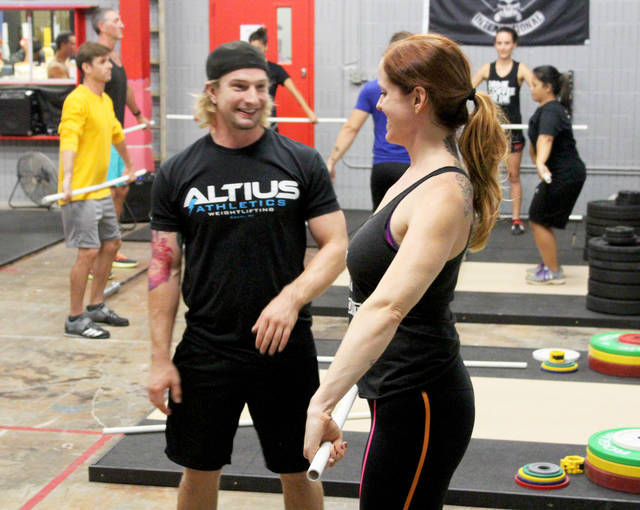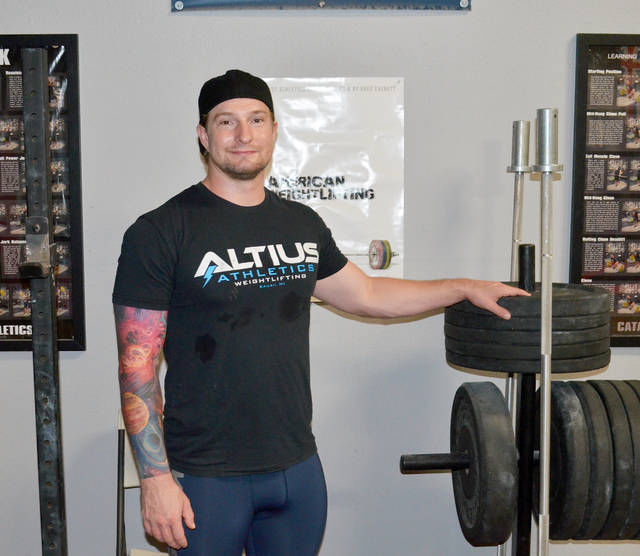Talk Story: Mac O’Neill
Sometimes, the most rudimentary tasks are also the most difficult.
As instructor Mackenzie O’Neill explained, Olympic-style weightlifting consists of two main lifts. Simple enough, right? But it’s easier said than done.
As someone who’s also well-versed in CrossFit, he said staying focused on one detail rather than several all at once can be challenging.
O’Neill, who is the head coach and co-owner of Altius Athletics in Kapaa, sat down with The Garden Island and talked about his own experience with the sport, opening the training facility on Kauai, and coaching aspiring weightlifters who are preparing for the Hawaii State Weightlifting Championships on Saturday in Honolulu.
So, do you specialize in weightlifting, or are there others disciplines you teach?
Well, mostly these days the main focus is Olympic-style weightlifting.
Two lifts — the snatch, and the clean and jerk.
The snatch, you take the barbell from the floor to overhead in one movement. And then the clean and jerk, you take it from the floor to your shoulders, and then overhead to finish the lift.
How long have you been doing this?
This gym’s been open since November, so we’re coming up on our one-year anniversary. … (Personally), I’ve had experience with Olympic-style weightlifting since 2008.
What got you interested in this kind of work?
Initially, I got introduced to it in my buddy’s offseason strength and conditioning program. He was a football player at North Central Illinois.
I was living in Illinois at the time. And then I found CrossFit later on, and then I got more experience with it. Then I slowly transitioned from CrossFit to exclusively weightlifting.
Was it difficult transitioning?
The toughest part with CrossFitters when we get in here is giving up, when you come from CrossFit you feel like you have to do everything all the time really hard and really fast. I’m sure you’ve seen the CrossFit Games. You’re doing all sorts of stuff all the time, right?
A lot of people don’t realize it but weightlifting, the sport itself after you’ve been in it for a while, is very monotonous — doing the same thing over and over, and you’re focusing on very small details. So, sometimes it’s hard to get somebody to commit to just focusing on one sport when they feel like, “Oh, I need this conditioning aspect to stay lean.” Or, “I need this whole CrossFit style” to achieve their goals. But a lot of their goals can be achieved in here, whether it’s weight loss, weight gain, speed development, agility, power, strength. All those things.
So, the tough part was staying focused on one thing rather than going hard on everything.
It definitely took a while for me, myself, to make that transition. I’ve had that experience with some people who were still CrossFitting part-time. You don’t get strong from coming in here and lifting a really heavy thing. You get strong from going home and recovering from lifting the really heavy thing.
If they come here and work their ass off and then they leave and go over to CrossFit, they start to dig themselves a hole with fatigue. When they’re just starting to work out or they’re getting introduced to this, they don’t realize they’re slowing their own development.
So, you’re originally from Illinois?
I’m originally from Michigan.
How long have you lived here?
I’ve been living on Kauai for 2 1/2 years. And I was living on the Big Island for four or five years before that.
On the Big Island, I was working at CrossFit Kona. I ran the Olympic weightlifting program and development at that gym.
What brought you here?
I work at Sunshine Helicopters. I’m a pilot.
So, what led to opening Altius Athletics?
Honestly, the initial push was probably very selfish. I wanted a place to train, and I wanted to develop a community and a group of people to train with. I was like, “I’m going to open this gym. I’m going to get all these crazy guys, and we’re going to push each other and have this crazy training atmosphere. It’s really going to take my lifting to the next level.” But what I really got was a bunch of people that had never touched a barbell before.
I’m not working out with them. I’m giving them my full attention when I’m in here, and we ended up here with something pretty amazing. We’re introducing weightlifting, as sport that’s been around for 100 years that most people still don’t know about.
We just had two 13-year-olds sign up the other day. I got a 15-year-old that I’m taking Weightlifting Championships on Oahu. We have another 19-year-old kid that’s looking to qualify for Junior Nationals. These were people that weren’t coming from CrossFit. They were maybe coming in here running on the treadmill. They’re baristas at Java Kai. They’re regular people. They had no experience and had no idea of what they were getting into, but turned out to be the best weightlifters.
And really, for longevity of the sport (and) to put the U.S. back into the upper echelon competing with the other countries … to get the U.S. back on the world stage again, we need to get kids involved at a young age, get them excited about it, fuel the fire. Those are the ones you can develop long-term. The guy that comes in like me, at 25 and finally decides he wants to do it, unless he was probably playing a Division I sport in college is not going to have the strength background to take it to the next level.
These 13-year-old girls that come in. If they stick with it, they’re your new American records, world records (and) medals at the Olympics. That’s what we’re hoping to bring back to the U.S.
Was there a lot of interest when you guys first started?
Surprisingly, we did. So, we’ve gone about it in different ways. When we first opened, we were like, “We’re going tor run two-week courses to introduce people to weightlifting.” For that one, we had 10, 11, 12 people sign up, which is pretty good. We only have three platforms in here. Once you get more than three people on a platform, it starts to get a little crazy unless everybody knows what they’re doing. They can take a long time, so they have to be on top of it.
Not everybody signed up to join the monthly membership afterwards. After that, we stopped holding the two-week courses. … When we’re doing something as technical as Olympic weightlifting, some people (who are) athletes can pick it up really quick. And then some people that have never touched a barbell before, and maybe never jumped rope before and aren’t very athletic, they take a lot more attention. So when you have both those kinds of people in the same class, when they’re being introduced to Olympic-style weightlifting, you either have one person standing there waiting while you’re working with person who’s not very good. Or you have that one person who’s not very good getting neglected because we’re moving through the process too quickly.
Now, we do one-on-one sessions. You can book them with a friend or something. We can do two or three people at a time. For the most part, you’ll come in, you’ll do two one-on-one sessions with me, and then you basically graduate into the regular class.
So, tell me about this Oahu competition.
It’s the Hawaii Weightlifting State Championships. … There’s qualifying totals. Those qualifying totals, they’re not outrageous. You don’t have to hit them at a meet. You just have to have done it in training at some point.
So, we have the snatch and the clean and jerk, right? We do a lot of other things in here to improve those, but in competition those are your two lifts. You have three attempts at each, six total. Your best lift between the two is called your total. … Let’s say I snatch 50 and I clean and jerk 60, my total is 110. And we’ll say the qualfying total for an 100-pound girls is 110, for example. She’s going to need to open within 15 kilos of that total, so we’ll call it 85 or 95. So, she opens with 45 and 40, so she meets the qualifying requirement.
It’s not an outrageous standard. Anybody who’s been training for a while should be able to meet some of those totals.
Does the qualifying totals vary by age or weight?
OK. So the qualifying total is restricted only to senior athletes. So you’re looking at, I want to say, 21 to 34 or 35 (years old) is the senior range. After 35, I think, you’re a masters athlete, and then from 21 to about 18 is juniors. And then under 18 is youth athletes. Youth, juniors and masters, they don’t need to qualify. It’s a 15 and 20 rule — 15 for women, and 20 for men. It’s just for the senior athletes.
So, I’m taking a 15-year-old girl over there (to the State Championship). She’ll be competing. She doesn’t have to worry about meeting this standard, which is good. It’s what you want. Yeah, we want to cater to these senior athletes. But the most important people that we can get out on stage (are the younger people). If she came to me and said she wants to compete, we got to get them out. Let them lift. Fuel the fire. Keep them excited about weightlifting and keep them in the sport.
So how many are you taking to Oahu?
I’m only taking two over. I asked the whole group about it a few months back. Most of them said they didn’t want to go over for it. Sometimes, it’s hard to get people to travel to compete. We’re going to, hopefully, hold a meet here in November — our one-year anniversary meet. So, we’ll all be able to compete in that. And other people from the other island can come and compete if they want.
I’m bringing Carlie Lindsey and Les Aki. … (Aki), he just turned 19.
So, tell me more about these two.
This is Carlie’s first competition. She’s only been with us around six weeks. She approached Dave and said, “I’m thinking of going over there just to watch the competition.” Dave was like, “If you’re going to go watch, you can compete if you want to.” She got really excited and fired up about that. If they want to be on that stage competing, the more experience, the better.
Les, this will be his second meet. His first one was in January, and he’s been with us since we opened the gym. So, he’s one of the original guys. … I can’t describe how much he’s improved.
Are you competing as well?
No. I’m just coaching.
As a coach, seeing your student improve must be gratifying.
It’s definitely the most rewarding part. a) I get to show them something I love. And b) they fall in love with it. And seeing their development over time is just incredible.




